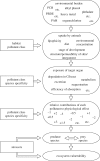Anthropogenic pollutants: a threat to ecosystem sustainability?
- PMID: 19833650
- PMCID: PMC2781844
- DOI: 10.1098/rstb.2009.0122
Anthropogenic pollutants: a threat to ecosystem sustainability?
Abstract
Pollutants, including synthetic organic materials and heavy metals, are known to adversely affect physiological systems in all animal species studied to date. While many individual chemicals can perturb normal functions, the combined actions of multiple pollutants are of particular concern because they can exert effects even when each individual chemical is present at concentrations too low to be individually effective. The biological effects of pollutants differ greatly between species reflecting differences in the pattern of exposure, routes of uptake, metabolism following uptake, rates of accumulation and sensitivity of the target organs. Thus, understanding of the effects of pollutants on wildlife and ecosystems will require detailed study of many different species, representing a wide range of taxa. However, such studies can be informed by knowledge obtained in more controlled conditions which may indicate likely mechanisms of action and suitable endpoint measurements. Responses may be exacerbated by interactions between the effects of pollutants and environmental stressors, such as under-nutrition or osmotic stresses and so changes in such variables associated with climatic changes may exacerbate physiological responses to pollutant burdens.
Figures
Similar articles
-
The endocrine effects of mercury in humans and wildlife.Crit Rev Toxicol. 2009;39(3):228-69. doi: 10.1080/10408440802233259. Crit Rev Toxicol. 2009. PMID: 19280433 Review.
-
Endocrine-disrupting chemicals and climate change: A worst-case combination for arctic marine mammals and seabirds?Environ Health Perspect. 2006 Apr;114 Suppl 1(Suppl 1):76-80. doi: 10.1289/ehp.8057. Environ Health Perspect. 2006. PMID: 16818250 Free PMC article. Review.
-
Fifteen years after "Wingspread"--environmental endocrine disrupters and human and wildlife health: where we are today and where we need to go.Toxicol Sci. 2008 Oct;105(2):235-59. doi: 10.1093/toxsci/kfn030. Epub 2008 Feb 16. Toxicol Sci. 2008. PMID: 18281716 Free PMC article. Review.
-
Embryos as targets of endocrine disrupting contaminants in wildlife.Birth Defects Res C Embryo Today. 2011 Mar;93(1):19-33. doi: 10.1002/bdrc.20202. Birth Defects Res C Embryo Today. 2011. PMID: 21425439 Review.
-
Endocrine disruptors and other food-contaminating environmental pollutants as risk factors in animal reproduction.Reprod Domest Anim. 2008 Jul;43 Suppl 2:15-22. doi: 10.1111/j.1439-0531.2008.01138.x. Reprod Domest Anim. 2008. PMID: 18638101 Review.
Cited by
-
Variability in the dynamics of mortality and immobility responses of freshwater arthropods exposed to chlorpyrifos.Arch Environ Contam Toxicol. 2011 May;60(4):708-21. doi: 10.1007/s00244-010-9582-6. Epub 2010 Aug 15. Arch Environ Contam Toxicol. 2011. PMID: 20711777 Free PMC article.
-
Actinobacteria: An eco-friendly and promising technology for the bioaugmentation of contaminants.Biotechnol Rep (Amst). 2021 Oct 5;32:e00679. doi: 10.1016/j.btre.2021.e00679. eCollection 2021 Dec. Biotechnol Rep (Amst). 2021. PMID: 34660214 Free PMC article. Review.
-
Impacts of climate change and environmental factors on reproduction and development in wildlife.Philos Trans R Soc Lond B Biol Sci. 2009 Nov 27;364(1534):3313-9. doi: 10.1098/rstb.2009.0175. Philos Trans R Soc Lond B Biol Sci. 2009. PMID: 19833643 Free PMC article.
-
Ambient Particulate Matter Exposure and Under-Five and Maternal Deaths in Asia.Int J Environ Res Public Health. 2019 Oct 12;16(20):3855. doi: 10.3390/ijerph16203855. Int J Environ Res Public Health. 2019. PMID: 31614721 Free PMC article.
-
Polybrominated diphenyl ethers in the environmental systems: a review.J Environ Health Sci Eng. 2021 Apr 15;19(1):1229-1247. doi: 10.1007/s40201-021-00656-3. eCollection 2021 Jun. J Environ Health Sci Eng. 2021. PMID: 34150307 Free PMC article. Review.
References
-
- Amezaga M. R., Bellingham M., Evans N. P., Cotinot C., Sharpe R. M., Rhind S. M., McNeilly A. S., Fowler P. A.2008. Ewes exposed to a cocktail of environmental chemicals as fetuses have fewer primordial follicles. Proc. Soc. Reprod. Fertil., 29 June–1 July 2008, Edinburgh, UK, pp. 68 See http://www.srf-reproduction.org/meetings/conf2008/progabstractbook.pdf; accessed 02 September 2009
-
- Anway M. D., Skinner M. K.2006Epigenetic transgenerational actions of endocrine disruptors. Endocrinology 147, S43–S49 (doi:10.1210/en.2005-1058) - DOI - PubMed
-
- Batty J., Leavitt R. A., Biondot N., Polin D.1990An ecotoxicological study of a population of the white footed mouse (Peromyscus leucopus) inhabiting a polychlorinated biphenyls-contaminated area. Arch. Environ. Contam. Toxicol. 19, 283–290 (doi:10.1007/BF01056098) - DOI - PubMed
-
- Beketov M. A., Liess M.2005Acute contamination with esfenvalerate and food limitation: chronic effects on the mayfly, Cloeon dipterum. Environ. Toxicol. Chem. 24, 1281–1286 (doi:10.1897/04-256R1.1) - DOI - PubMed
-
- Bellingham M., Fowler P. A., Amezaga M. R., Rhind S. M., Cotinot C., Mandon-Pepin B., Sharpe R. M., Kyle C. E., Evans N. P.2009Exposure to a complex cocktail of environmental endocrine disrupting compounds disturbs the KiSS-1/GPR54 system in ovine hypothalamus and pituitary gland. Environ. Health Perspect See http://ehp.niehs.nih.gov/docs/2009/0900699/abstract.html. (doi:10.1289/ehp.0900699) - DOI - PMC - PubMed
Publication types
MeSH terms
Substances
LinkOut - more resources
Full Text Sources



